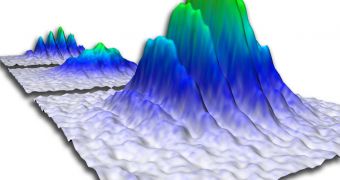A group of investigators based at the University of Bristol, in the United Kingdom, announces the development of a new type of optical chip, which can be used to handle entanglement and mixture.
These are two critically-important quantum phenomena that need to be harnessed in order to allow for the construction of quantum computers. The new optical chips can be used to generate these two states, manipulate them, and even measure them.
Scientists with the UB Center for Quantum Photonics (CQP) say that this achievement may prove to be extremely important for the manufacturing of the first quantum computer. They say that being able to control entanglement closely is something that has never been demonstrated fully before.
Quantum entanglement is a state whereby two particles are connected to each other regardless of distance. This means that changing one's spin will automatically lead to the other changing its own speed, even if the distance between the two implies breaking the speed of light.
Experts hope to use constructs of up to six entangled particles, either photons or electrons. The amount of data such a quantum bit (qubit) could carry would far exceed anything possible with existing technologies. The new, tiny silica chip may be all that is needed to produce and control this state.
“In order to build a quantum computer, we not only need to be able to control complex phenomena such as entanglement and mixture, but we need to be able to do this on a chip, so that we can scalably and practically duplicate many such miniature circuits,” UB professor Jeremy O'Brien explains.
“Our device enables this and we believe it is a major step forward towards optical quantum computing,” adds the investigator, who is also the director of the Center for Quantum Photonics. He adds that the new photonic chip measures only 70-by-3 millimeters.
It was developed so that it works for basic light particles, since it contains a small network of tiny channels. These structures are used to manipulate single photons into interacting and becoming entangled, or for creating any possible mixed state for any single photon.
“It isn’t ideal if your quantum computer can only perform a single specific task. We would prefer to have a reconfigurable device which can perform a broad variety of tasks, much like our desktop PCs today - this reconfigurable ability is what we have now demonstrated,” Peter Shadbolt adds.
“This device is approximately ten times more complex than previous experiments using this technology. It’s exciting because we can perform many different experiments in a very straightforward way, using a single reconfigurable chip,” the expert adds.
Shadbolt is the lead author of a new study detailing the findings, which appears in a recent issue of the top scientific journal Nature Photonics.

 14 DAY TRIAL //
14 DAY TRIAL //